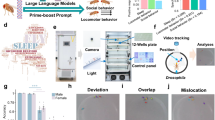Abstract
-
1.
Flights of three big brown bats (Eptesicus fuscus) landing on a hand and catching a suspended mealworm were video analysed.
-
2.
Results were consistent with the bats using the same basic control procedure in the quite different approach tasks — namely keeping τ(r) = k rand τ(a)τ(r) = k αr. Here r is the current distance to the destination; α is the angle between the current direction of the destination and the goal direction of final approach (β min); τ(r) = r/r, \(\tau (\alpha ) = \alpha /\dot \alpha \); and k r, k αr are constants.
-
3.
The bats were each quite consistent on a particular task (hand or mealworm) in the values they used for the control parameters k r, k αrand β min. However, different values were used in the two tasks, which reflected the different behaviour required at the destination. Flights to hand required twisting and landing upside down and approach angle β min was closer to vertical and k rwas smaller and corresponded to decelerating nearly to a stop. In contrast, the mealworms were caught in mid flight and approach angle β min was shallower and speed of approach was about constant.
-
4.
τ(r) might be registered acoustically by τ(echo-delay) or by τ(echo-intensity). τ(α) might be registered by the bat's directional hearing and gravity sense.
-
5.
The bats learned the tasks easily, suggesting that the control procedure they used in the experiments was part and parcel of the natural skills they had developed in the wild.
Similar content being viewed by others
References
Dear SP, Simmons JA, Fritz J (1993) A possible neuronal basis for representation of acoustic scenes in auditory cortex of the big brown bat. Nature 364: 620–623
Dusenbery DB (1992) Sensory ecology: how organisms acquire and respond to information. Freeman, New York
Griffin DR (1958) Listening in the dark. Yale University Press, New Haven
Gustafson Y, Schnitzler HU (1979) Echolocation and obstacle avoidance in the hipposiderid bat Asellia tridens. J Comp Physiol 131: 161–167
Lee DN (1976) A theory of visual control of braking based on information about time-to-collision. Perception5: 437–459
Lee DN, Reddish PE, Rand DT (1991) Aerial docking by hummingbirds. Naturwissenschaften 78: 526–527
Lee, DN, Weel, FR van der, Hitchcock, T, Matejowsky E & Pettigrew, JD (1992). Common principle of guidance by echolocation and vision. J Comp Physiol A, 171: 563–571
Lee DN, Davies MNO, Green PR, van der Weel FR (1993) Visual control of velocity of approach by pigeons when landing. J Exp Biol 180: 85–104
Schiff W, Oldak R (1990) Accuracy of judging time-to-arrival: effects of modality, trajectory, and gender. J Exp Psych: Human Perception and Performance 16: 303–316
Schnitzler HU (1973) Control of Doppler shift compensation in the greater horseshoe bat Rhinolophus ferrumequinum. J Comp Physiol 82: 79–92
Simmons JA (1989) A view of the world through the bat's ear: the formation of acoustic images in echolocation. Cognition 33: 155–199
Simmons JA, Ferragamo M, Moss CF, Stevenson SB, Altes RA (1990) Discrimination of jittered sonar echoes by the echolocating bat, Eptesicus fuscus: The shape of the target images in echolocation. J Comp Physiol A 167: 589–616
Simmons JA, Kick JA (1983) Interception of flying insects by bats. In: Huber F, Mark H (eds) Behavioral physiology and neuroethology: roots and growing points. Springer, New York, pp 267–279
Wotton J (1993) The basis of vertical sound localization of the FM bat, Eptesicus fuscus: acoustical cues and behavioral validation. PhD dissertation, Brown University, Providence, RI
Author information
Authors and Affiliations
Rights and permissions
About this article
Cite this article
Lee, D.N., Simmons, J.A., Saillant, P.A. et al. Steering by echolocation: a paradigm of ecological acoustics. J Comp Physiol A 176, 347–354 (1995). https://doi.org/10.1007/BF00219060
Accepted:
Issue Date:
DOI: https://doi.org/10.1007/BF00219060




